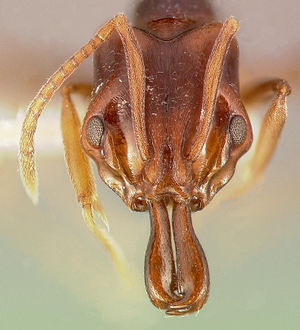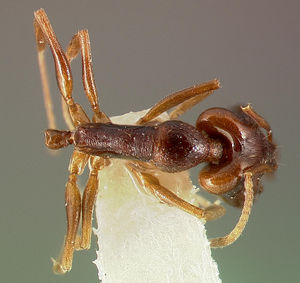Anochetus bequaerti
| Anochetus bequaerti | |
|---|---|

| |
| Scientific classification | |
| Kingdom: | Animalia |
| Phylum: | Arthropoda |
| Class: | Insecta |
| Order: | Hymenoptera |
| Family: | Formicidae |
| Subfamily: | Ponerinae |
| Tribe: | Ponerini |
| Genus: | Anochetus |
| Species: | A. bequaerti |
| Binomial name | |
| Anochetus bequaerti Forel, 1913 | |
| Synonyms | |
| |
Identification
Keys including this Species
Distribution
Latitudinal Distribution Pattern
Latitudinal Range: 4° to -28.98333°.
| North Temperate |
North Subtropical |
Tropical | South Subtropical |
South Temperate |
- Source: AntMaps
Distribution based on Regional Taxon Lists
Afrotropical Region: Benin, Central African Republic, Democratic Republic of Congo (type locality), Guinea, Ivory Coast, Kenya, South Africa, Uganda, United Republic of Tanzania, Zimbabwe, Zimbabwe.
Distribution based on AntMaps
Distribution based on AntWeb specimens
Check data from AntWeb
Countries Occupied
| Number of countries occupied by this species based on AntWiki Regional Taxon Lists. In general, fewer countries occupied indicates a narrower range, while more countries indicates a more widespread species. |

|
Estimated Abundance
| Relative abundance based on number of AntMaps records per species (this species within the purple bar). Fewer records (to the left) indicates a less abundant/encountered species while more records (to the right) indicates more abundant/encountered species. |

|
Biology
|
Castes
Worker
          
| |
| . | |
Queen
   
| |
| . | |
Nomenclature
The following information is derived from Barry Bolton's Online Catalogue of the Ants of the World.
- bequaerti. Anochetus bequaerti Forel, 1913b: 309 (w.) DEMOCRATIC REPUBLIC OF CONGO.
- Type-material: holotype worker.
- Type-locality: Democratic Republic of Congo (“Congo belge”): Katanga, Bukama (J. Bequaert).
- Type-depository: MRAC.
- Arnold, 1915: 104 (q.m.).
- Status as species: Forel, 1913j: 203; Arnold, 1915: 103 (redescription); Forel, 1916: 400; Wheeler, W.M. 1922a: 99, 791; Bernard, 1953b: 211; Brown, 1978c: 556, 603; Bolton, 1995b: 63; Hita Garcia, et al. 2013: 219.
- Senior synonym of abstracta: Brown, 1978c: 556; Bolton, 1995b: 63.
- Senior synonym of estus: Brown, 1978c: 556; Bolton, 1995b: 63.
- Senior synonym of opaciventris: Brown, 1978c: 556; Bolton, 1995b: 63.
- Distribution: Cameroon, Democratic Republic of Congo, Gabon, Ghana, Guinea, Ivory Coast, Kenya, South Africa, South Sudan, Zimbabwe.
- abstracta. Anochetus bequaerti st. abstracta Santschi, 1914e: 12 (w.) SOUTH AFRICA.
- Type-material: holotype worker.
- Type-locality: South Africa: Natal, Amanzimtote, 21.i.1905 (I. Trägårdh).
- Type-depository: unknown (not NHMB (Baroni Urbani, 1973b: 142-143); perhaps NHRS).
- Subspecies of bequaerti: Wheeler, W.M. 1922a: 791; Arnold, 1926: 214.
- Junior synonym of bequaerti: Brown, 1978c: 556; Bolton, 1995b: 63.
- estus. Anochetus estus Wheeler, W.M. 1922a: 98 (w.) DEMOCRATIC REPUBLIC OF CONGO.
- Type-material: holotype worker.
- Type-locality: Democratic Republic of Congo (“Belgian Congo”): Akenge, from stomach of toad (H.O. Lang & J.P. Chapin).
- Type-depository: AMNH.
- Status as species: Wheeler, W.M. 1922a: 791.
- Junior synonym of bequaerti: Brown, 1978c: 556; Bolton, 1995b: 64.
- opaciventris. Anochetus opaciventris Wheeler, W.M. 1922a: 98 (w.) DEMOCRATIC REPUBLIC OF CONGO.
- Type-material: 3 syntype workers.
- Type-locality: Democratic Republic of Congo (“Belgian Congo”): Akenge, from stomach of toads (Bufo funereus and polycercus) (H.O. Lang).
- Type-depository: MCZC.
- Status as species: Wheeler, W.M. 1922a: 791.
- Junior synonym of bequaerti: Brown, 1978c: 556; Bolton, 1995b: 65.
Description
References
- Arnold, G. 1915. A monograph of the Formicidae of South Africa. Part I. Ponerinae, Dorylinae. Ann. S. Afr. Mus. 14: 1-159 (page 104, queen, male described)
- Brown, W. L., Jr. 1978c. Contributions toward a reclassification of the Formicidae. Part VI. Ponerinae, tribe Ponerini, subtribe Odontomachiti. Section B. Genus Anochetus and bibliography. Studia Entomologica. 20:549-638. (page 556, senior synonym of abstracta, esstus and opaciventris)
- Forel, A. 1913b. Formicides du Congo Belge récoltés par MM. Bequaert, Luja, etc. Rev. Zool. Afr. (Bruss.) 2: 306-351 (page 309, worker described)
- Taylor, B., Agoinon, N., Sinzogan, A., Adandonon, A., Kouaguou, Y. N., Bello, S., Wargui, R., Anato, F., Ouagoussounon, I., Houngbo, H., Tchibozo, S., Todjihounde, R., Vayssieres, J.F. 2018. Records of ants (Hymenoptera: Formicidae) from the Republic of Benin, with particular reference to the mango farm ecosystem. Journal of Insect Biodiversity 8(1): 6-29 (doi:10.12976/jib/2018.08.1.2).
References based on Global Ant Biodiversity Informatics
- Belshaw R., and B. Bolton. 1994. A survey of the leaf litter ant fauna in Ghana, West Africa (Hymenoptera: Formicidae). Journal of Hymenoptera Research 3: 5-16.
- Brown Jr., W.L. 1978. Contributions toward a reclassification of the Formicidae. Part VI. Ponerinae, Tribe Ponerini, Subtribe Odontomachiti, Section B. Genus Anochetus and Bibliography. Studia Entomologia 20(1-4): 549-XXX
- Brown W.L. Jr. 1978. Contributions toward a reclassification of the Formicidae. Part VI. Ponerinae, tribe Ponerini, subtribe Odontomachiti. Section B. Genus Anochetus and bibliography. Studia Ent. 20(1-4): 549-638.
- Forel A. 1913. Formicides du Congo Belge récoltés par MM. Bequaert, Luja, etc. Revue Zoologique Africaine (Brussels). 2: 306-351.
- Hita Garcia, F., G. Fischer, M.K. Peters, R.R. Snelling and H.W. Wagele. 2009. A preliminary checklist of the ants (Hymenoptera: Formicidae) of Kakamega Forest (Kenya). Journal of East African Natural HIstory 98(2): 147-165.
- IZIKO South Africa Museum Collection
- Medler J. T. 1980: Insects of Nigeria - Check list and bibliography. Mem. Amer. Ent. Inst. 30: i-vii, 1-919.
- Stephens S. S., P. B. Bosu, and M. R. Wager. 2016. Effect of overstory tree species diversity and composition on ground foraging ants (Hymenoptera: Formicidae) in timber plantations in Ghana. International Journal of Biodiversity Science, Ecosystem Services & management 12(1-2): 96-107.
- Taylor B. 1976. Ants of the Nigerian Forest Zone (Hymenoptera: Formicidae). I. Ponerinae, Cerapachyinae, Pseudomyrmecinae. Cocoa Research Institute of Nigeria Technical Bulletin Series 4: 1-41.
- Taylor B., N. Agoinon, A. Sinzogan, A. Adandonon, Y. N'Da Kouagou, S. Bello, R. Wargui, F. Anato, I. Ouagoussounon, H. Houngbo, S. Tchibozo, R. Todjhounde, and J. F. Vayssieres. 2018. Records of ants (Hymenoptera: Formicidae) from the Republic of Benin, with particular reference to the mango farm ecosystem. Journal of Insect Biodiversity 8(1): 006–029.
- Wheeler W. M. 1922. Ants of the American Museum Congo expedition. A contribution to the myrmecology of Africa. II. The ants collected by the American Museum Congo Expedition. Bulletin of the American Museum of Natural History 45: 39-269.
- Wheeler W. M. 1922. Ants of the American Museum Congo expedition. A contribution to the myrmecology of Africa. VIII. A synonymic list of the ants of the Ethiopian region. Bulletin of the American Museum of Natural History 45: 711-1004

